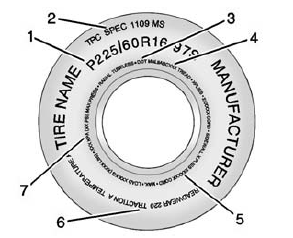Chevrolet Spark Owners Manual: Tire Sidewall Labeling
Useful information about a tire is molded into its sidewall. The examples show a typical passenger tire sidewall.

Passenger (P-Metric) Tire Example
(1) Tire Size: The tire size is a combination of letters and numbers used to define a particular tire's width, height, aspect ratio, construction type, and service description. See the “Tire Size” illustration later in this section for more detail.
(2) TPC Spec (Tire Performance Criteria Specification): Original equipment tires designed to GM's specific tire performance criteria have a TPC specification code molded onto the sidewall.
GM's TPC specifications meet or exceed all federal safety guidelines.
(3) DOT (Department of Transportation): The Department of Transportation (DOT) code indicates that the tire is in compliance with the U.S. Department of Transportation Motor Vehicle Safety Standards.
DOT Tire Date of Manufacture: The last four digits of the TIN indicate the tire manufactured date. The first two digits represent the week (01-52) and the last two digits, the year. For example, the third week of the year 2010 would have a four-digit DOT date of 0310.
(4) Tire Identification Number (TIN): The letters and numbers following the DOT code are the Tire Identification Number (TIN).
The TIN shows the manufacturer and plant code, tire size, and date the tire was manufactured. The TIN is molded onto both sides of the tire, although only one side may have the date of manufacture.
(5) Tire Ply Material: The type of cord and number of plies in the sidewall and under the tread.
(6) Uniform Tire Quality Grading (UTQG): Tire manufacturers are required to grade tires based on three performance factors: treadwear, traction, and temperature resistance. For more information see Uniform Tire Quality Grading on page 10-52.
(7) Maximum Cold Inflation Load Limit: Maximum load that can be carried and the maximum pressure needed to support that load.
 Summer Tires
Summer Tires
This vehicle may come with high performance summer tires. These tires have a
special tread and compound that are optimized for maximum dry and wet road performance.
This special tread and compound ...
 Tire Designations
Tire Designations
Tire Size
The following is an example of a typical passenger vehicle tire size.
(1) Passenger (P-Metric) Tire: The United States version of a metric tire sizing
system. The letter P as the fir ...
Other materials:
Traction Control System (TCS)/StabiliTrak Light
The StabiliTrak or Traction Control
System (TCS) indicator/warning light comes on briefly when the engine is started.
If the light does not come on, have the vehicle serviced by your dealer.
If the system is working normally, the indicator light turns off.
If the light is on and not flashing, ...
Interior Glass
To clean, use a terry cloth fabric dampened with water. Wipe droplets left behind
with a clean dry cloth.
Commercial glass cleaners may be used, if necessary, after cleaning the interior
glass with plain water.
Caution
To prevent scratching, never use abrasive cleaners on automotive
glass. ...
Introduction
The names, logos, emblems, slogans,
vehicle model names, and vehicle body designs appearing in this manual including,
but not limited to, GM, the GM logo, CHEVROLET, the CHEVROLET Emblem, and SPARK
are trademarks and/or service marks of General Motors LLC, its subsidiaries, affiliates,
or li ...
